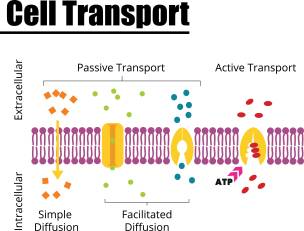Cells have certain ways to move molecules inside and outside of their cells. In diffusion, molecules move from an area of high concentration to an area of low concentration. In osmosis, water molecules move from an area of high concentration to an area of low concentration.
| Active Transport | Passive Transport |
| The transport of molecules across a cell membrane. | Mechanism in cells that is used for the movement of molecules across a cell membrane. |
| Uses energy from the cell. | Doesn’t use energy from the cell. |
| Faster in process. | Slower in process. |
| Can move larger molecules across the cell membrane. | Can only move molecules from a place of higher concentration to a place of lower concentration. |
| Specific. | Not specific. |

How about active and passive transports? In this article, we will discuss the differences between active and passive transports and how they work.
Active transport is the transport of molecules across a cell membrane. Active transport is used to help the plant absorb water, minerals, and nutrients. Active transport uses energy from the cell, while passive transport doesn’t.
Passive transport is a mechanism in cells that is used for the movement of molecules across a cell membrane. Passive transport is used to help the plant absorb water, minerals, and nutrients.
Nutrients and minerals are passively transported into the root hair cells of a plant. The cell membrane is selectively permeable, meaning that it only allows certain molecules to cross it.
Water and other small molecules can cross the cell membrane by diffusion, while larger molecules, such as minerals, are passively transported across the membrane by a process called facilitated diffusion.
In active transport, the cell uses energy to pump molecules across the cell membrane. This process is used to move molecules against a concentration gradient, or from a place where there is a lot of a molecule to a place where there is less of the molecule.
For example, the cell might use active transport to pump sugar molecules from the soil into the plant’s roots.
Active transport has advantages over passive transport. Active transport can move molecules against a concentration gradient, which means that the cell can get more of a molecule from one side of the membrane to the other. Active transport can also move larger molecules across the cell membrane.
While passive transport does not require energy from the cell, it is a slower process than active transport. Passive transport can only move molecules from a place of higher concentration to a place of lower concentration.
Other differences between the two of them include the following:
- Active transport is specific, meaning that it can only transport certain molecules across the membrane.
- Passive transport is not specific, and can transport any type of molecule across the membrane.
- Active transport is a more recent discovery than passive transport.
Scientists are still learning about the differences between active and passive transport, and more information may be discovered in the future.





